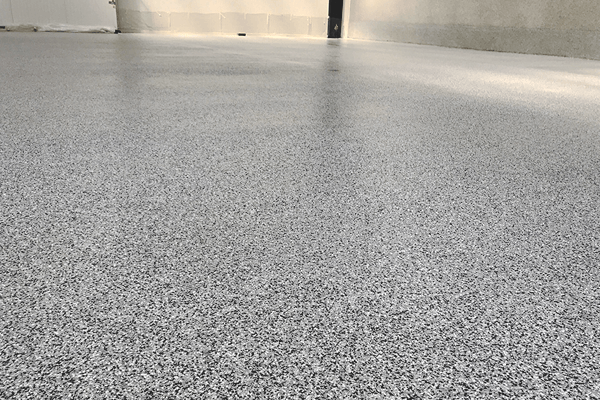Many homeowners dread having to fix or repair their basement after floods or after any type of dampness/moisture or wetness is found. Wet basements are not only a nuisance to deal with, but they can also cause health problems while potentially causing extensive damage that is very costly to repair (of course, this depends on the extent of the water damage to your basement).
Wet basements can arise for a number of reasons, such as cracks in the foundation of your home, inadequate drainage, leakage through window wells, and missing or damaged gutters and downspouts (among others).
Luckily, there are a handful of ways to deal with wet basement floors, including raised floor tiles, creating vapor barriers, and using epoxy paint on top of concrete floors to block out moisture.

Contents
Causes of Wet Basements
There are numerous causes of wet basements. These include:
- Cracks in the foundation of your home (Cracks in the foundation of your home may occur in the walls and the floor)
- Inadequate drainage
- Leakage through windows due to improper window wells
- Missing or damaged gutters and/or downspouts
- There may be other causes of wet basements, such as a damaged/burst pipe, inadequate grading (in which the ground around your house slopes towards it, causing water to flow towards the basement), and ineffective draining
Each of these causes can lead to trapped or excess moisture in the walls (which eventually seep down towards the ground) and basement floor of your home. As mentioned earlier, wet basements can be costly to repair (depending on the extent of water damage) but can also cause health problems. Mold and mildew fester and grow in damp environments and can lead to significant health problems, like respiratory issues. Prior to implementing one of the wet basement flooring solutions, you should ensure that you properly address the root cause/issue of the moisture in your basement. Mold and mildew will continue to grow and spread in damp areas; if you simply cover it up, it won’t go away.
Wet Basement Flooring Solutions
Luckily, there are a variety of solutions and options for wet basements in terms of flooring. These options include:
- Outdoor Ground Landscaping
- Raised Floor Tiles with a Vapor Barrier
- Creating Vapor Barriers
- Epoxy Paint and Sealed Concrete Floors
- Other solutions, such as replacing or repairing gutters or downspouts, using a dehumidifier, or a sub-slab depressurization system
All of the aforementioned options/solutions will be discussed in greater detail below.
Outdoor Ground Landscaping
Making sure that your lawn is graded in the proper direction (so that the flow of water is directed away from your house), leave a space between mulch and the side of your home, and ensure you are keeping grass and other plants around the exterior of your home healthy.
Pros: Proper landscaping is an easy solution to helping to prevent moisture from entering your basement. You can choose to do the landscaping and maintenance yourself or hire someone to do it for you
Cons: While proper landscaping can help prevent a wet basement, this is not a long-term solution to dealing with your wet basement floor, as it will just divert water from your basement moving forward (it’s not a direct solution to deal with your wet basement floors).
Raised Floor Tiles with a Vapor Barrier
Raised floor tiles with a vapor barrier are a great solution for wet basement flooring. Raised floor tiles with built-in vapor barriers prevent moisture by creating a space or gap between the concrete layer and your floor. Water or moisture dissipates before it has the chance to pool and cause damage to your floors. Raised floor tiles with built-in vapor barriers are available in different finishes, such as carpet, vinyl, and tile.
Pros: Raised floor tiles with a built-in vapor barrier allows air to flow between the concrete slab layer and your flooring, effectively preventing water from pooling and causing damage. Raised floor tiles allow for any moisture to disappear without requiring you to remove the floor every time water builds up. Raised floor tiles with built-in vapor barriers are simple to install and are extremely effective.
Cons: Depending on your desired style, raised floor tiles with built-in vapor barriers can range in price from $5.00-$10.00 per square foot (prices can vary greatly from region to region).
Creating Vapor Barriers
Vapor barriers are typically a thin layer of an impermeable material, most often plastic or foil sheets, that are able to resist the transmission of water through walls, floors, or ceilings. Vapor barriers are effective at resisting moisture; however, they should be thought of more as a preventative measure rather than as a solution to a wet basement.
Pros: Vapor barriers are very effective at preventing water damage and they can lower the risk of health issues related to mold and mildew
Cons: Vapor barriers must be installed within the layers of building materials (such as between the concrete layer of your basement floor and the surface layer of your floor), which will likely require you to remove a layer or two of building materials to install the vapor barrier
Epoxy Paint OverSealed Concrete Floors
Epoxy paint is a paint mixture that is made of a resin and hardener, meant to coat and seal surfaces. Epoxy paint is very effective at sealing surfaces and ensuring materials are resistant to water. Epoxy paint over existing concrete floors is a great way to protect your basement floor from water damage.
Pros: Epoxy coatings are resistant to germs and bacteria, is not affected by water (water sits on top of the epoxy coating), and also protects the concrete layer of your basement floor from potential cracks or stains.
Cons: Preparing your basement floor for epoxy paint may be time consuming and require extensive labor; epoxy paint also has a very strong smell; however, this should dissipate after the epoxy paint has dried.
Ceramic Tile
Ceramic tiles are another great option for wet basement flooring. Ceramic tiles are extremely durable and water-resistant; you want to ensure that you select ceramic tiles that are glazed (or treated) with a protective coating. You can install ceramic tile directly on top of the concrete slab layer of your basement floor.
Pros: Ceramic tiles are available in a wide variety of patterns and colors. Ceramic tiles are resistant to mold and mildew.
Cons: You may want to hire a professional to install ceramic tiles on your basement floor, which can be costly. Ceramic tiles can also be fairly expensive, ranging anywhere from $8-$12 per square foot.
Floating Floors
Floating floors are essentially any type of floor that isn’t glued or nailed to the subfloor. Basically, the floating floor sits atop a moisture barrier (or vapor barrier) which is directly on top of the concrete slab.
Pros: A variety of materials can be used for floating floors, such as carpet tiles, laminate, and engineered hardwood flooring.
Cons: Floating floors are only effective if they sit atop a vapor barrier; they will not work if they are placed directly on the concrete slab of your basement floor.
Other Solutions for Wet Basement Flooring
Replacing or Repairing Gutters or Downspouts
You should evaluate your gutters and downspouts (located on the exterior of your home) to determine if there are any portions that are missing or in need of repair.
Pros: If your wet basement is caused by ineffective or damaged gutters or downspouts, repairing or replacing them should be a relatively inexpensive solution (of course, you must still deal with the wet basement as a result of the gutters or downspouts).
Cons: This approach should only be consulted after you remove any source of moisture or dampness from inside the basement of your home (just replacing/repairing gutters or downspouts doesn’t solve the issue of your wet basement floor).
Using a Dehumidifier
By using a dehumidifier in your wet basement, it can help reduce odors associated with dampness and any humidity that is a result of built-up moisture.
Pros: Dehumidifiers aren’t expensive and can help reduce humidity and odors.
Cons: Using a dehumidifier is not a permanent solution; it’s meant to be used as a temporary solution to deal with the effects or symptoms of a wet basement (odor and humidity).
Installing a Sub-Slab Depressurization System
A sub-slab depressurization system is an arrangement of PVC pipes and a fan that prevents vapors from entering your home by redirecting them into the soil surrounding the exterior of your home.
Pros: Sub-slab depressurization systems use relatively little electricity (they must run constantly to be effective) and are quiet. They also require minimal maintenance.
Cons: A sub-slab depressurization system must be installed, which requires significant renovation, which can be costly depending on the contractor or professional installing it.
Final Words
There are countless options for wet basement flooring. If you ever have to deal with a wet basement, you should first ensure that you are addressing the root cause of the leak/entrance point (whether it’s from a crack in the foundation, missing or damaged gutters or downspouts, or another cause). There are a variety of flooring options available to you to for your basement flooring, including ceramic tiles, floating floors, or using epoxy paint; there are many other options. Whichever wet basement solution you select, it’s best to consider the cost, amount of time and labor required, and the long-term maintenance (if applicable) of the option.
